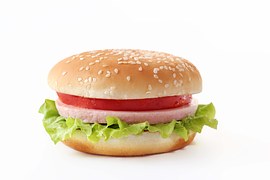 How is public speaking like cooking? Imagine you walk into a diner. You open the menu and order a hamburger. Your mouth is watering for that juicy burger. The aroma of sizzling beef wafts toward you as the waiter brings it to your table.
How is public speaking like cooking? Imagine you walk into a diner. You open the menu and order a hamburger. Your mouth is watering for that juicy burger. The aroma of sizzling beef wafts toward you as the waiter brings it to your table.
The server places the dish in front of you and suddenly you do a double take. Sitting on top of the bun is the burger! It's messy and greasy. How are you supposed to eat that? Isn't the burger supposed to be in between the buns? You feel confused, disappointed, and irritated at the server who should know how to serve up a sandwich.
Most likely you've never had this experience in a restaurant. But I'll guarantee that many of us have had that experience at a conference or meeting.
Just as the diner anticipates the meal, the audience anticipates the speech. They expect the public speaker to know how to deliver the presentation. It's not enough to have good platform skills if the speech or presentation is disorganized.
Much like the burger on top of the bun, many public speakers begin with details making the message confusing and difficult to follow. The result is indigestion. The audience can't digest the message because they don't know what they are listening for.
Consider a leader I coached who was losing credibility when she spoke to senior management. After listening to her presentation, I was confused. She had a clear call to action. I knew what she wanted but I had no idea how she got there. We were both lost in the weeds of details that led nowhere.
The remedy was simple: SAVE THE MEAT FOR THE MIDDLE. Think of the top of the bun as your opening and the bottom of the bun as your conclusion. The opening and conclusion of the presentation usually take the same amount of time to deliver. The bulk of the speech is saved for the body, or the middle of the presentation. Begin with the overview, then dive into the details, and then recap the main points.
After we reworked the client's structure, she gave the presentation and was able to win approval for her project.
When you use the sandwich technique, you'll reduce your preparation time because you'll have a clear and simple format. Your audience will be able to follow your message because it will flow. So set the table with your opening, feed them appetizing ideas they can chew on, and save the meat for the middle. When you use this recipe, you'll influence your audience and get your just desserts!


 Today is Take a Second Look Day. That means it's a day to repurpose, reuse, or redistribute your content. It can apply to anything in your life. Since many public speakers freeze when they have to prepare a speech or presentation, I thought it would be valuable to apply this "Take a Second Look" concept to preparing a presentation.
Panel Presentations
Let's say you're asked to speak on a panel or to give a stand-up presentation on your topic of expertise. You're staring at a blank piece of paper and wondering how to begin. Who says you have to start from scratch? Use what you already have done. Take a look at past presentations, documents, proposals, blogs, and articles you're written. What is the main topic or theme? How can you repackage it?
Today is Take a Second Look Day. That means it's a day to repurpose, reuse, or redistribute your content. It can apply to anything in your life. Since many public speakers freeze when they have to prepare a speech or presentation, I thought it would be valuable to apply this "Take a Second Look" concept to preparing a presentation.
Panel Presentations
Let's say you're asked to speak on a panel or to give a stand-up presentation on your topic of expertise. You're staring at a blank piece of paper and wondering how to begin. Who says you have to start from scratch? Use what you already have done. Take a look at past presentations, documents, proposals, blogs, and articles you're written. What is the main topic or theme? How can you repackage it?